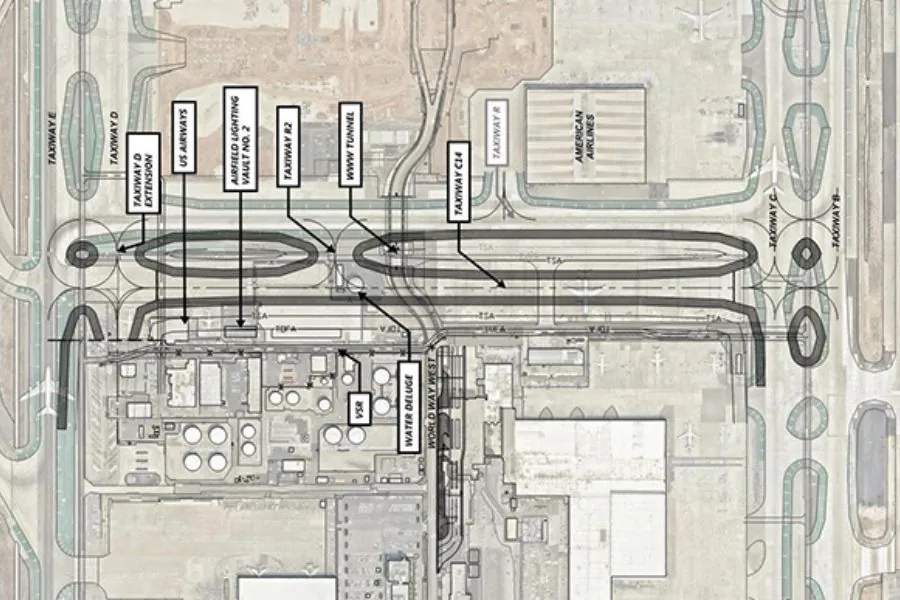Taxiway Reconstruction Builds on LAX Relationship

To say projects at Los Angeles International Airport (LAX) are complex would be an understatement: thousands of flights a day, millions of people each year, innumerable stakeholders – and to top it all, a fixed amount of space for growth, with development on three sides and the Pacific Ocean on the other.
RS&H’s Aviation Practice has met these complexities head-on over its seven-year relationship with the airport. In fact, the Practice has been so successful that RS&H is the only firm to be reselected three times in a row at LAX as planning service providers.
The Aviation team continues to build upon that near-decade relationship as it executes design and construction phase services for the new Taxiway C-14 project. The new taxiway, which will sit between the airport’s north and south runway complexes, will accommodate the large Airbus 380 and Boeing 747-8 aircraft that frequent the airport.
Site Constraints Require Innovative Design Solutions
Due to its space limitations, the airport must keep all new development within its existing borders. So, for the new taxiway to be built, several existing facilities must be moved or demolished.
Notable examples in this project include the modification of a large airfield electrical vault building and the replacement of a 550,000-gallon deluge supply system providing fire protection to an existing mega-size aircraft hangar. The project also necessitates the roadway closure and infill of an underpass that an existing taxiway and vehicle service road bridge cross.
“As you can see, this is not just a taxiway construction project,” said aviation engineer Byron Chavez. “We look at it as five main projects: the taxiway itself, the reduction of the airfield electrical vault, replacement of the water deluge system, closure and infill of the World Way West underpass, and a variety of smaller enabling projects.”
Electrical Vault & Deluge System
An airport electrical vault in the path of the taxiway presented a unique problem. One-third of the vault rests within space reserved for Taxiway C-14. Moving or demolishing it is not feasible, however, since the electrical vault powers LAX’s north side.
To work around this issue, the RS&H team designed a reduction of the building to two-thirds its original size.
Also in the path of future Taxiway C-14 is the American Airlines mega-hangar’s current water deluge supply system, made up of the above-ground tank and a pump house.
The RS&H team’s design replaces the current water deluge supply system by connecting the hangar to an existing underground system in the vicinity that supplies two other large hangars.
World Way West
The World Way West underpass will also be put out of commission by the new taxiway. In addition to facilitating typical utilities relocation and abandonment, the RS&H team advised the airport on the best way to deal with the major taxiway bridge over the World Way West underpass. A backfill solution of various embankment materials provided the best balance of economy, rapid installation, and minimum disruption to existing operations.
Stakeholder Coordination
Projects at the airport typically have many stakeholders, given the number of airlines that land at LAX and the number of personnel needed to keep the second busiest airport in the United States running. The Taxiway C-14 design project is no different.
This project had a particularly long list of stakeholders, since the various sub-projects (known as enabling projects) impacted a large number of airport tenants and users.
“During the planning and design, we needed to coordinate with various groups including the Aircraft Rescue and Firefighting Station personnel, Air Traffic Control, Airport Operations, LAXFuel, various commercial airlines and airport operators that were impacted by the project,” Byron said.
To add complexity to the situation, the team determined the taxiway construction will need to take part in over 20 phases, so as not to disrupt the airport’s daily functions.
In one phase, crews will only be able to work after the service day is over. That will give workers a very short window of time, since the airport’s service day lasts from 5 a.m. to 1:30 a.m.
Shaping the Future
But for the Los Angeles team, this project is not one of challenges, but one of continued opportunities.
The taxiway design is yet another LAX project that lets associates help shape the future of one of the longest-running, busiest airports in the world.
“That’s the kind of work you hope for when you decide on a career in the aviation industry,” said Byron. “Working with LAX has been a wonderful experience, and we’re looking forward to continuing to grow our relationship with the airport.”
The team began the Taxiway C-14 design phase in September 2017. Construction is anticipated to begin in the fall of 2019.
